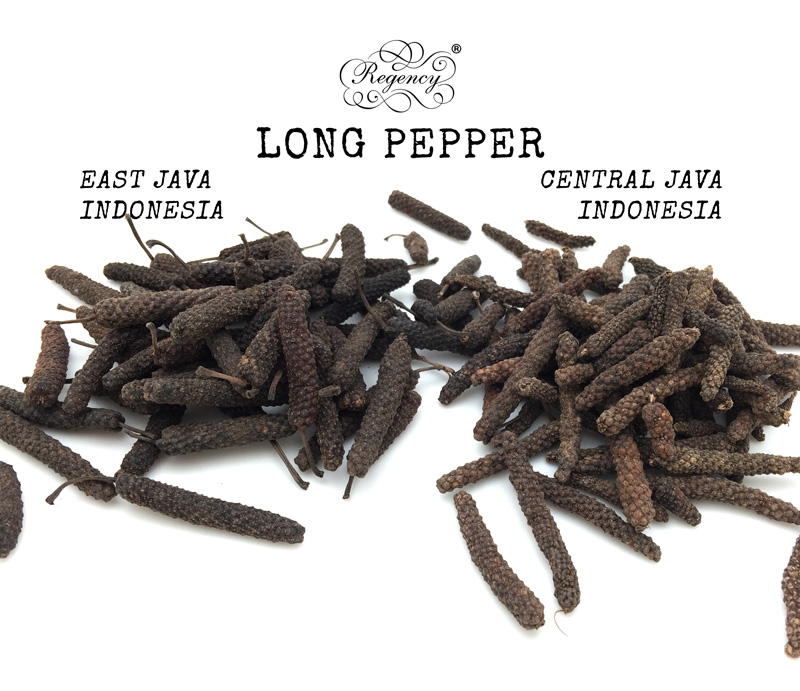Long Pepper Indonesia has been very popular in ancient times, for its medical and dietary properties not only in Asia, but widely used by the Greeks and the Romans. As a matter of fact, it is one of the earliest spices to have reached Europe, and was used as a currency!

After the introduction of the black pepper in Europe, because of it’s higher price, the fame of the long pepper quickly faded away. Let’s see where the Long Pepper is placed nowadays.
Long Pepper is a close relative to Black Pepper, with similar taste but hotter and slightly sweeter than the better-known black peppercorn. The flavor can be thought has somewhat similar to cinnamon and nutmeg. Long Pepper is often used in Indian, Indonesian, Malaysian cuisine and some North African spice mixtures. For cooking, it can be used whole, shaved or crushed. A whole spice will bring a lot of flavor, whereas shaved or crushed it will make the recipe hot and spicy, particularly when freshly ground.
In European cooking it is used in the famous Italian dish Osso Bucco and in some recipes for strawberry jam. Long Pepper pairs delightfully with acidic fruits and tomato based sauces. Long Pepper is also making a come back thanks to the medicinal properties it has. It naturally contains Piperlongumine, which according to research (referenced below), has shown anti-cancer properties and can naturally fight some types of cancer cells. In mice, Piperlongumine is also found to inhibit the growth of malignant breast tumors. It is able to do this more effectively than even chemotherapy used for treating breast cancer as the experiments showed, which we feel is truly remarkable and deserving of further attention.
Long Pepper also naturally contains the chemical piperine, in lower doses (around 1-2%) compared to commercially available black pepper (5-9%). Piperine has been investigated by significant government funded research for its health benefits. In animals it has shown anti-inflammatory capabilities, it also exhibits some anti-mutagenic and anti-tumor influences. Scientific research has also delved into the details of how it has been used for centuries to treat pain, flu, muscle aches, and stimulate appetite, gathering effectiveness… which certainly exists.

There are two main Long Peppers cultivars in the world: in Northern India and Indonesia. Indonesian Long Pepper is longer and sweeter, in contrast to Indian Long Pepper, which is still relatively new (Indonesia has been a producer for thousands of years and produces several times more than India). It naturally grows better in Indonesia, and this is where ours comes from. Of course, Indonesia too has many different varieties of the spice. Our long pepper hails from the spice islands in Central Java, where it is picked in the wild. It does not come from plantations or farmland – which is very different compared to most spices. That said, like many other spices, it is picked while still relatively young to preserve its full flavor, as is tradition with Long Pepper. The long peppers are then naturally sun dried.
Our Eastern Java variety of Long Pepper is much darker in colour. It’s shorter, but fatter, and has a stronger taste. It’s much more spicy, and also contains sweet chocolate overtones – we guess from the cocoa growing in the region!

The Central Java variety is longer, but more red/brown in colour. The taste is still the signature long pepper spice, but not as strong or as pronounced as the eastern java variety. Colour wise it’s also lighter, and we’ve noted some of our buyers prefer the rich, dark coloured long pepper as it results in a gorgeous dark powder when ground.

Market Price for Regency quality (East Java, Indonesian, Dark, Premium Selected grade) today:
55G GLASS JAR HKD 48 / USD 6.00
100G REFILL BAG HKD 40 / USD 5.00
500G REFILL BAG HKD 164 / USD 20.50
1KG WHOLESALE PACK** HKD 298 / USD 37.25
References
http://www.nature.com/nature/journal/v475/n7355/full/nature10167.html
http://www.sciencedaily.com/releases/2011/07/110713131421.htm
http://www.ncbi.nlm.nih.gov/pubmed/26140520
http://www.ncbi.nlm.nih.gov/pubmed/17987447
http://www.ncbi.nlm.nih.gov/pmc/articles/PMC4309837/